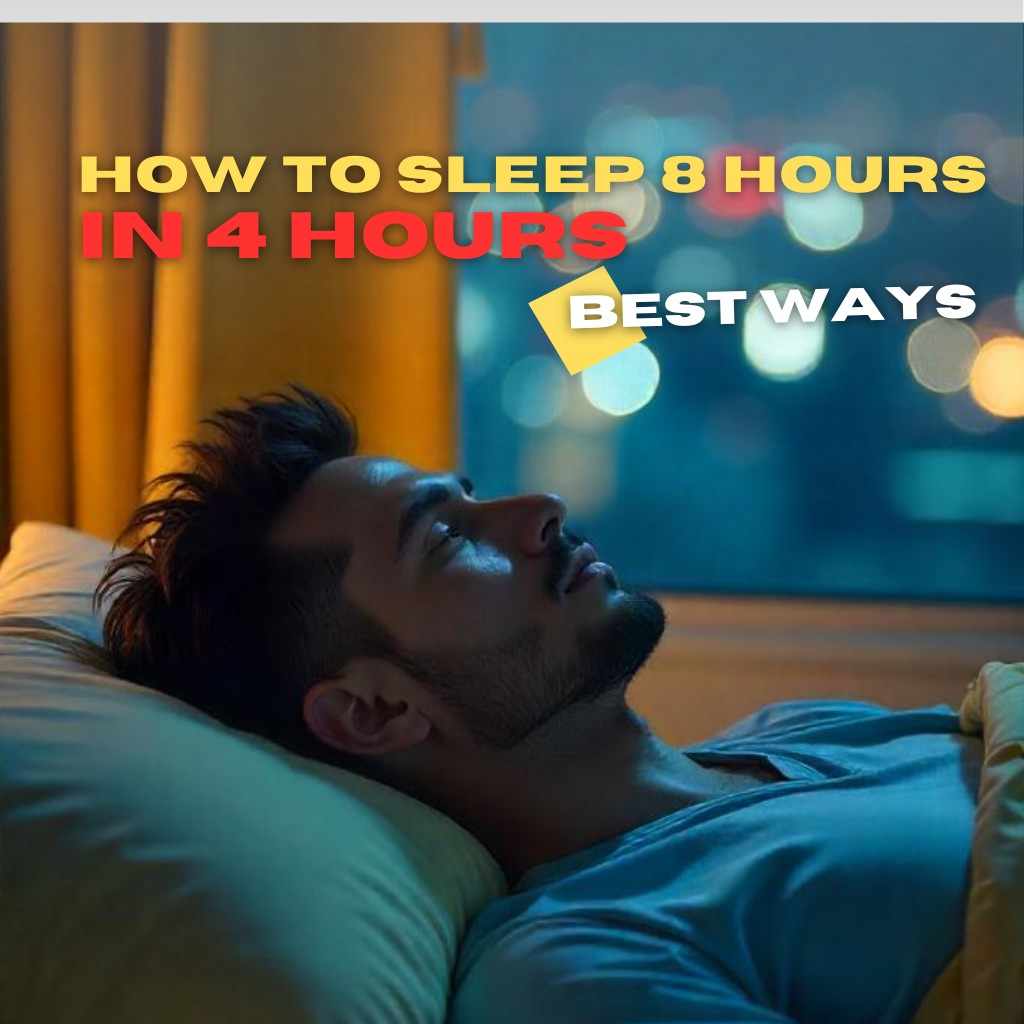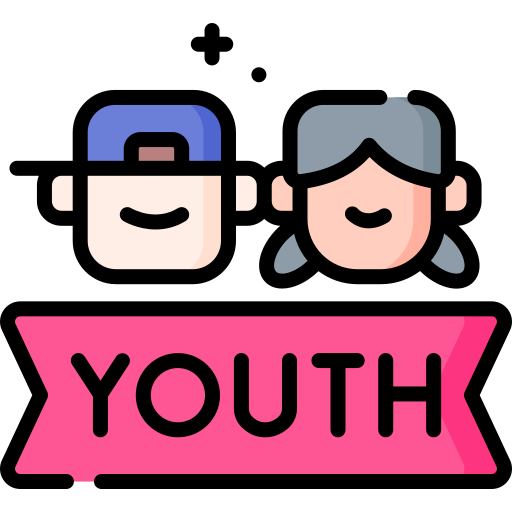How to Sleep 8 Hours in 4 Hours Imagine being able to get the full value of 8 hours of sleep—deep recovery, clear mind, physical rejuvenation—in just 4 hours. In our perpetually on, go-go world, sleep is more often a time-grabbing indulgence than it used to be. With work, duties, and personal aspirations competing for attention, many of us are on the lookout for ways to sleep less without losing energy or performance. That is why the idea of “sleeping 8 hours in 4” has attracted so much interest.
This concept isn’t about bypassing rest—it’s about biohacking to optimize your sleep. By applying specific strategies, it might be possible to cut sleep time without waking up groggy, unfocused, or unsatisfied. From polyphasic sleep patterns to sophisticated biohacking techniques, individuals are testing the limits of compressing sleep without dismantling health and productivity.
But can it be backed by science when it comes to something so drastic? And is it safe to do so? In this article, we’re going to examine whether you really can “train” your body to require less sleep—without sacrificing the benefits of a full night’s sleep. Let’s get deep into the potential.
Table of Contents
ToggleUnderstanding Sleep
The Science Behind Sleep Cycles
Sleep is not merely something one does when they are unconscious. It’s an extremely active process in which your brain and body experience cycles—each essential for repair, memory consolidation, and hormone balance.
You sleep through 4-6 sleep cycles every night, each of which takes around 90 minutes. Each sleep cycle contains several stages, ranging from light sleep to deep restorative stages.
What Goes on in Every Sleep Stage
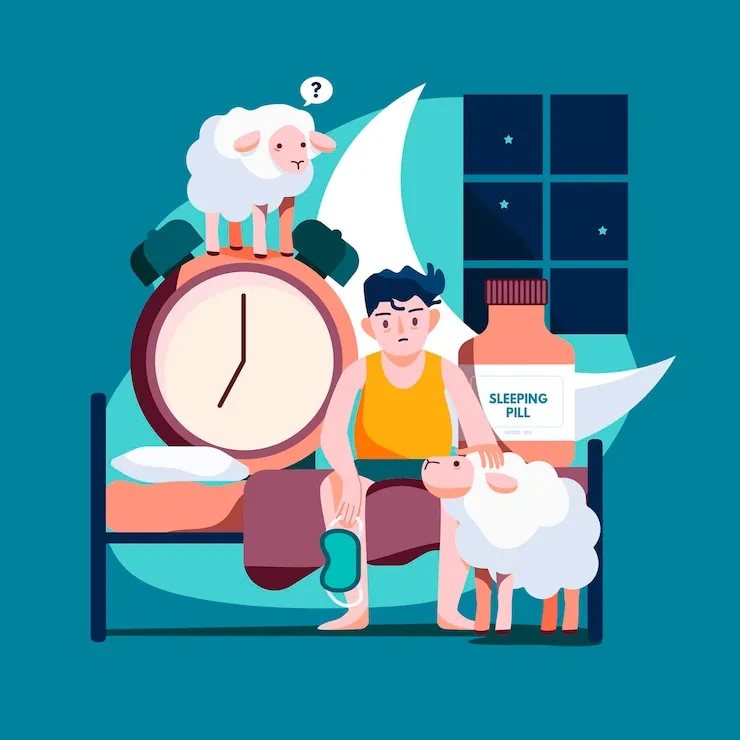
NREM Stages
- Stage 1: This is the stage of dozing off. Your body starts to relax, and brain activity begins to slow down.
- Stage 2: A stage that is deeper where body temperature falls and heart rate decreases.
- Stage 3:Also referred to as deep sleep or slow-wave sleep. It’s the most restorative stage. Your body repairs and regenerates.
REM Stage
REM (Rapid Eye Movement) sleep is where the majority of dreaming happens. It’s essential for cognitive function, learning, and memory consolidation.
Why 8 Hours is the Standard
The “8-hour rule” is founded on average biological requirements. It guarantees your body receives sufficient of every sleep phase. But the twist—is that you don’t require 8 hours if you can optimize quality instead of quantity.
Can You Sleep Less but Feel Completely Rested?
Sleep Efficiency vs. Sleep Quantity
Rather than tallying hours, consider how effectively your body cycles through sleep phases. Great sleep efficiency indicates that you’re spending more time in deep and REM sleep even if the total time is limited.
Real-Life Examples
- Einstein adored 10 hours at night.
- Tesla, however, slept only 2 hours a day and yet created groundbreaking concepts.
These stories illustrate the differences in sleep needs. But keep in mind: Einstein’s long sleeps were restorative, and Tesla’s technique likely aren’t for everyone.
Polyphasic Sleep: The Key to Sleeping Less?
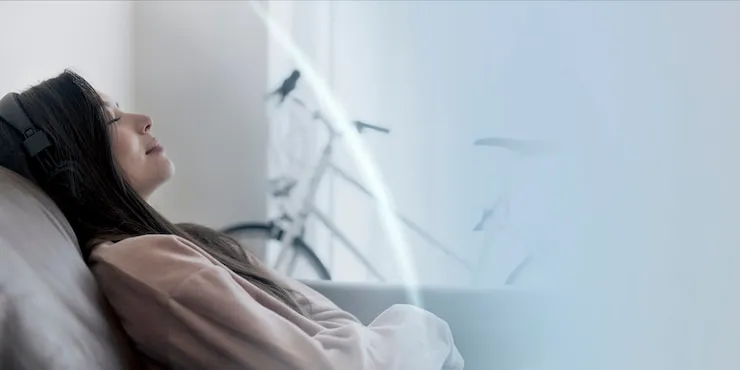
What is Polyphasic Sleep?
Polyphasic sleep is the practice of splitting your sleep into several short naps or segments rather than one big session.
Different Types of Polyphasic Schedules
Uberman
- 6 naps of 20 minutes, every 4 hours apart.
- Total sleep: 2 hours/day
Everyman
- 1 core sleep (3 hours) + 3 naps (20 minutes each).
- Total sleep: 4–5 hours/day
Dymaxion
- 4 naps of 30 minutes.
- Total sleep: 2 hours/day
Risks and Rewards
Though polyphasic sleep will liberate hours in your day, it’s not without its adverse effects—such as social isolation, brutal discipline, and physical strain. Most individuals can’t keep it up long term.
Biohacking Your Sleep
What is Biohacking?
Biohacking is the art of maximizing biological function with science, technology, and self-experimentation. When it comes to sleep, it’s engineering the shortest, most efficient rest possible.
Tools and Techniques to Improve Sleep
Sleep Tracking Devices
- Oura Ring, Whoop, and Fitbit assist in tracking sleep phases and identifying inefficiencies.
Light Therapy
- Replicates natural sunlight to reset circadian rhythms.
Supplements and Nootropics
- Melatonin, magnesium, L-theanine, and glycine assist in improving sleep onset and depth.
Deep Sleep Optimization Techniques
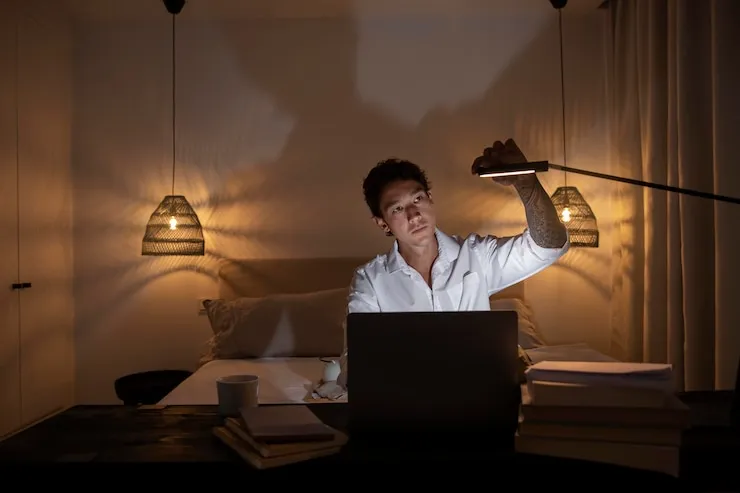
Ways to Get to Deep Sleep Quick
Cold Exposure at Night
- Taking a cold shower or having a cooling mattress pad can cool down your core temperature, prompting your body to sleep deeper.
Blue Light Blocking
- Blue light interferes with melatonin. Wear blue light glasses or enable “night mode” on devices post-sunset.
Sound and Frequency Therapy
Listening to binaural beats or 432Hz frequencies will calm your brain into deeper relaxation and sleep states quicker.
Breathing Techniques and Meditation
Box breathing, 4-7-8 technique, and guided meditations all reduce cortisol, leading to restful sleep.
Nutrition and Sleep
Foods that enhance the quality of sleep
- Cherries (natural melatonin)
- Almonds and walnuts (magnesium and healthy fats)
- Bananas (potassium and tryptophan)
Avoid these Before Bed
- Caffeine after 2 p.m.
- Heavy or spicy meals
- Alcohol—it disrupts REM
Sleep-Friendly Supplements
- Melatonin: Stimulates natural sleep signals
- Magnesium Glycinate: Tranquilizes nervous system
- Ashwagandha: Anxiousness and stress reducer
Exercise and Sleep Synergy
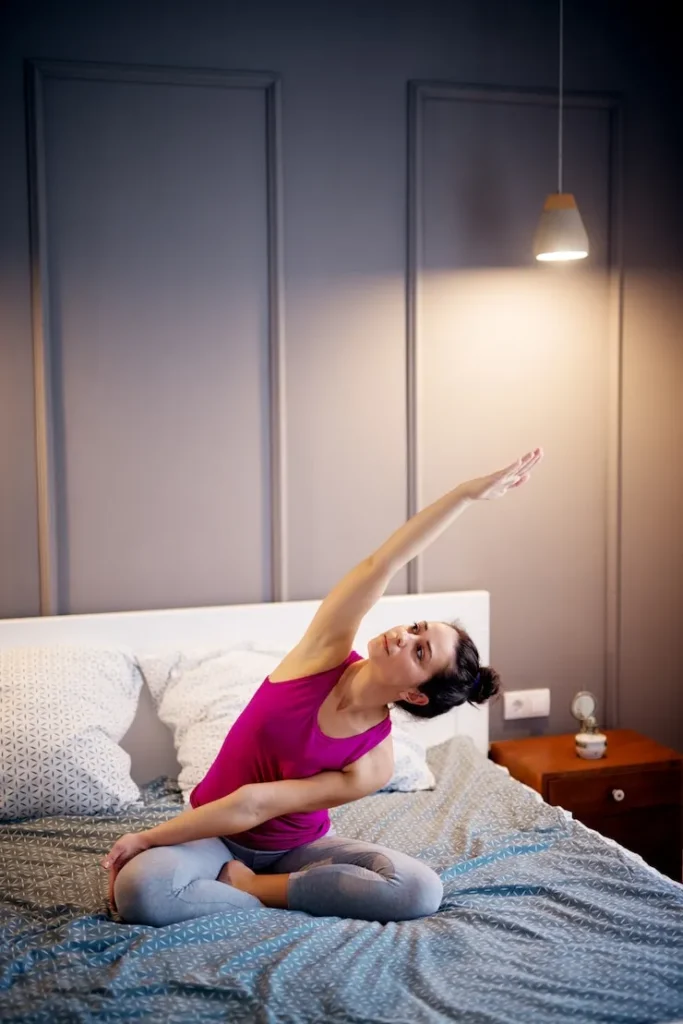
When and How to Exercise
Exercising in the morning allows you to fall asleep quicker and sleep more soundly. Steer clear of vigorous exercise close to bed—it elevates cortisol and body temperature.
Yoga and Stretching for Better Sleep
A soothing yoga session or 10 minutes of stretches before bedtime relaxes the mind and prepares your body for rest.
Technology Hacks for Sleep in Less Time
Smart Alarms
They wake you when you’re sleeping lightly, making you feel refreshed—even though you slept fewer hours.
Sleep Pods and Weighted Blankets
These devices aid in calming and inducing deeper, more restful sleep.
White Noise vs. Pink Noise
Pink noise has been demonstrated to improve deep sleep and memory consolidation more than white noise.
Mental Habits and Sleep Psychology
Bedtime Rituals and Mental Cues
Performing the same routine each evening—reading, lowering lights, brushing teeth—conditions your brain to understand it’s sleep time.
Eliminating Sleep Anxiety
Stress murders sleep quality. Journaling at bedtime or gratitude work may reduce mental chatter.
CBT-I (Cognitive Behavioral Therapy for Insomnia)
It remolds negative sleep habits and thoughts, promoting sleep efficiency naturally.
Case Studies and Real-Life Experiments

Polyphasic Sleep Diaries
Most online communities record successful (and unsuccessful) ventures into polyphasic sleep. Most use the standard response of improved mental acuity for the first few days, with burnout if improperly executed.
Famous Short Sleepers
- Leonardo da Vinci: Uberman cycle
- Napoleon Bonaparte: 4–5 hours/night
What Biohackers Are Saying
Influencers such as Tim Ferriss and Dave Asprey employ sleep monitoring, nootropics, and red light therapy to pack and intensify their sleep in an efficient manner.
Is It Safe to Sleep Less?
Medical Perspectives
Physicians caution that habitual sleep loss lowers immunity, raises blood pressure, and enhances risk of mental disorders.
When to Consult a Doctor
If you’re attempting sleep restriction and find yourself fatigued, irritable, or having trouble with memory—stop and speak with a professional.
Long-Term Consequences of Sleep Loss
It can damage mental function, decrease testosterone, and speed up aging. Always put quality first and take the easy route second.
A Balanced Strategy: Getting the Most from Your Sleep
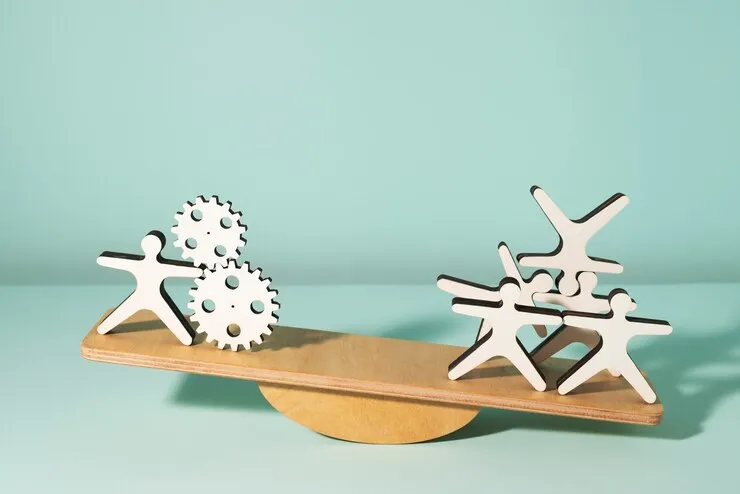
Discovering Your Individual Sleep Sweet Spot
Everyone’s biochemistry is unique. Some run on 6 hours. Others burn out without 8. Experiment with a sleep tracker to determine what works best for you.
Monitoring and Changing Your Sleep Strategy
Begin gradually. Reduce 15 minutes weekly while using sleep hacks. Track how you feel—don’t estimate.
Sophisticated Methods to Boost Sleep Efficiency
1. Strategic Napping
Naps are not for children—they’re the sleeping sidekick’s best-kept secret.
- Power Nap (10–20 mins):Enhances alertness and memory.
- 90-Minute Nap:Finishes a complete sleep cycle, perfect if you’re sleep-deprived at night.
- Timing Tip: Nap between 1–3 PM to prevent interfering with your primary sleep routine.
Pair naps with caffeine (a “coffee nap”)—consume a coffee and immediately nap for 20 minutes. You will wake up revitalized just as caffeine is starting to take effect.
2. Sleep Compression Training
Sleep compression steadily trims time in bed while augmenting sleep drive, enhancing sleep efficiency.
How to begin:
- Monitor how long you truly sleep (not time in bed).
- Gradually cut time in bed to align with actual sleep time.
- Once you sleep soundly in this window, add sleep time in 15-minute increments.
Target: Deep, effective sleep in a shorter time.
3. Red Light Therapy at Night
Red and near-infrared light naturally stimulate melatonin.
- Apply a red light panel 30–60 minutes before bedtime.
- Steer clear of blue light exposure entirely during this window.
This ramps up melatonin production, allowing you to fall asleep sooner and descend into deep sleep more quickly.
4. Hormonal Synchronization
Your circadian hormones regulate your sleep-wake pattern—primarily melatonin (sleepy) and cortisol (awakening).
Maximize this by:
- Taking sunlight exposure within 30 minutes of waking.
- Having a regular sleep routine, even on weekends.
- Not eating 2–3 hours prior to sleeping—digestion interferes with melatonin.
Sample Daily Routine for 4-Hour Efficient Sleep
Following is a high-performance timetable for deep sleepers who condense their rest:
| Time | Activity |
|---|---|
| 6:00 AM | Wake up, sunlight exposure, hydrate |
| 7:00 AM | Light exercise (walk/stretch/yoga) |
| 9:00 AM | Deep work session |
| 1:00 PM | Power nap (20 minutes) |
| 3:00 PM | Light snack + blue light break |
| 6:00 PM | Dinner (protein + fat, no sugar) |
| 7:30 PM | Wind-down routine begins (dim lights, no screens) |
| 8:00 PM | Red light therapy or meditation |
| 8:30 PM | Sleep |
| 12:30 AM | Wake, begin day |
Note: Note: Customize your routine. If 4 hours doesn’t work at first, try 5–6 and compress gradually.
Neuroscience Behind Sleep Compression
MIT and Stanford studies show that REM and deep sleep are out of proportion to your needs—you don’t require equal portions of each stage.
Sleep hackers utilize devices such as EEG sleep headbands (Muse, Dreem) to monitor brainwaves and learn to fall into deep sleep more quickly. This “neurofeedback” is the key to becoming a master of ultra-short sleep.
Emotional and Cognitive Tools for Improved Sleep
Visualization Before Sleep
Spend 5 minutes imagining a peaceful place or successful day. This primes the subconscious for restorative sleep and reduces night-time anxiety.
Gratitude Journaling
Jot down 3 things you’re grateful for before bed. This lowers cortisol levels, helps transition into rest, and enhances sleep quality—even if you’re only getting 4 hours.
Supplements to Stack for Maximum Rest
While natural methods are ideal, smart supplementation can fast-track sleep quality.
| Supplement | Benefit | Timing |
|---|---|---|
| Magnesium Glycinate | Muscle relaxation | 60 mins before bed |
| L-Theanine | Calms racing thoughts | 60 mins before bed |
| Apigenin | Naturally sedating flavonoid | With magnesium |
| Glycine | Lowers body temp | 30 mins before bed |
| Melatonin | Signals sleep onset | Use only short term |
### Tip:
Cycle supplements to prevent building tolerance.
The Mindset Shift: Quality Over Hours
We’ve all been taught that more sleep is better. But biohackers will tell you it’s not about how much, but about what type of sleep. You want to:
- Fall asleep quickly
- Get into deep sleep quickly
- Spend longer in REM and Stage 3 sleep
If you can manage this, 4–5 hours is sufficient—for some people.
Why Most People Can’t Sleep in 4 Hours
Let’s face it—not everyone can. Here’s why people fail:
- Poor sleep hygiene
- Inconsistent schedules
- Chronic stress
- Eating too late
- Trying to rush adaptation
This is a lifestyle change, not a magic trick. Be patient. Monitor everything. Treat your sleep like a science experiment.
Conclusion
Sleeping 8 hours in 4 isn’t a magic trick—it’s a combination of science, structure, and experimentation. For most, trimming sleep is about maximizing efficiency, not cheating biology. Use the techniques and tools discussed, and listen to your body. With the right approach, better rest in less time can become your new reality.
FAQs
1. Can you really train your body to sleep less?
Yes, with gradual adaptation, efficient sleep routines, and biohacks, it’s possible—but it doesn’t work for everyone.
2. Is polyphasic sleep suitable for everyone?
No. It’s extreme and can disrupt social life, mental health, and overall performance if not done right.
3. How long does it take to adapt to 4 hours of sleep?
It can take 2–3 weeks for your body to adjust, but most people feel significant fatigue early on.
4. What’s the safest way to start biohacking your sleep?
Begin with tracking your current sleep, improving sleep hygiene, and using supplements like magnesium before attempting drastic changes.
5. Does sleeping less affect your memory or productivity?
Yes—if sleep quality drops. However, improved efficiency in sleep stages can maintain or even boost performance short term.
Please don’t forget to leave a review.
